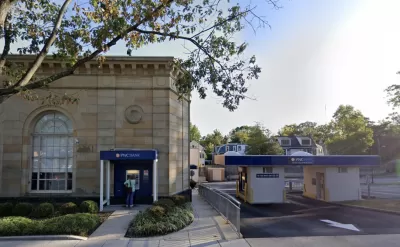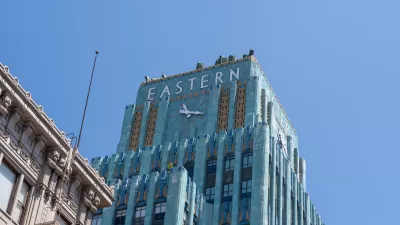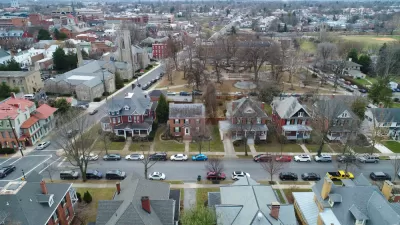The decision to protect a non-historic parking lot as part of designating an adjacent historic bank building is being derided by critics as another form of exclusionary zoning.

The inclusion of a parking lot in a historic landmark designation by the District of Columbia’s Historic Preservation Review Board (HPRB) is raising eyebrows, writes Nick Sementelli in Greater Greater Washington, causing concern among housing advocates who say the decision will limit any future development on the lot.
The historic building at the heart of the matter is the Chevy Chase Savings Bank on Connecticut Avenue. “The landmarking of the building follows HPRB’s established norms, but the inclusion of a parking lot adjacent to the site seems to violate the board’s own precedent and national historic guidance.”
Although “Using the historic nomination process like this to control future land use is supposed to be impermissible,” the HPRB acted on the claim from Historic Chevy Chase and the DC Preservation League (DCPL) that preserving the lot is important “to prevent too tall a building from being built on the lot in the future” and “ruin” the bank building’s ambiance.
According to DCPL Executive Director Rebecca Miller, “the bank and the parking lot share a single tax lot, and that DCPL uses tax-lot boundaries when drafting nominations.” The preservation groups say they are “not trying to prevent all development on the parking lot,” but having to go through historic design review in the future will likely ensure that any future building will be limited in size.
For Sementelli, “Preemptively limiting the scale of infill development on a parking lot by surreptitiously sliding it into a landmark application for a specific building” looks suspiciously like exclusionary zoning that “is supposed to be legally out of bounds.”
FULL STORY: DC’s historic board voted to protect a non-historic parking lot. Why?

Alabama: Trump Terminates Settlements for Black Communities Harmed By Raw Sewage
Trump deemed the landmark civil rights agreement “illegal DEI and environmental justice policy.”

Planetizen Federal Action Tracker
A weekly monitor of how Trump’s orders and actions are impacting planners and planning in America.

The 120 Year Old Tiny Home Villages That Sheltered San Francisco’s Earthquake Refugees
More than a century ago, San Francisco mobilized to house thousands of residents displaced by the 1906 earthquake. Could their strategy offer a model for the present?

In Both Crashes and Crime, Public Transportation is Far Safer than Driving
Contrary to popular assumptions, public transportation has far lower crash and crime rates than automobile travel. For safer communities, improve and encourage transit travel.

Report: Zoning Reforms Should Complement Nashville’s Ambitious Transit Plan
Without reform, restrictive zoning codes will limit the impact of the city’s planned transit expansion and could exclude some of the residents who depend on transit the most.

Judge Orders Release of Frozen IRA, IIJA Funding
The decision is a victory for environmental groups who charged that freezing funds for critical infrastructure and disaster response programs caused “real and irreparable harm” to communities.
Urban Design for Planners 1: Software Tools
This six-course series explores essential urban design concepts using open source software and equips planners with the tools they need to participate fully in the urban design process.
Planning for Universal Design
Learn the tools for implementing Universal Design in planning regulations.
Clanton & Associates, Inc.
Jessamine County Fiscal Court
Institute for Housing and Urban Development Studies (IHS)
City of Grandview
Harvard GSD Executive Education
Toledo-Lucas County Plan Commissions
Salt Lake City
NYU Wagner Graduate School of Public Service





























